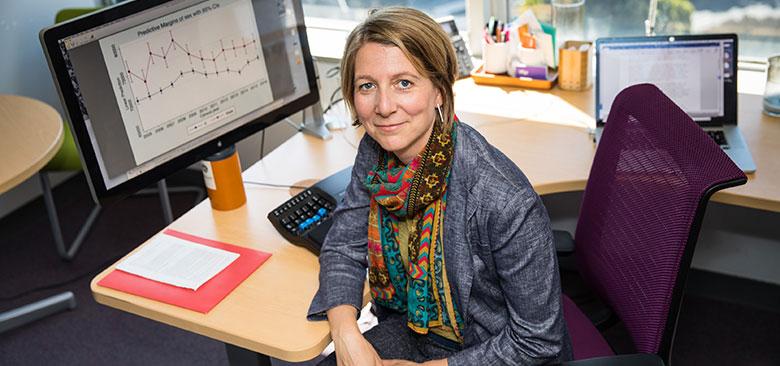
Ulrike Muench, assistant professor at the UCSF School of Nursing, led one of the first studies on NPs' opioid prescribing habits. (Photos by Elisabeth Fall)
NPs and Opioid Prescribing: What Don’t We Know?
As United States policymakers continue to seek ways to halt the opioid epidemic, key pieces of information are missing that could help shape solutions. One of the most glaring examples is the absence of information about nurse practitioner opioid prescribing patterns.
The information matters because nurse practitioners (NPs) account for the third-largest share of opioids prescribed in primary care, the practice setting that accounts for the largest percentage of opioid prescriptions in the U.S. In rural areas – where NPs are often the only primary care providers providing services to vulnerable populations – the opioid epidemic has been particularly fast-growing.
In an effort to close the gap and open a conversation on NP opioid prescribing, the UCSF School of Nursing’s Ulrike Muench led one of the first studies on the topic, publishing her findings in the June 2019 issue of Medical Care.
Less Opioids Prescribed, at Higher Doses
The study drew on data from 2009 to 2013 for more than 20,000 Medicare beneficiaries. It compared prescribing patterns of beneficiaries who were managed by NPs with those managed by physicians in states in which NPs are able to prescribe controlled substances without physician oversight.
In brief, the research team found that under NP management, Medicare beneficiaries were less likely to receive an opioid and less likely to be acute users at baseline. However, beneficiaries who did receive opioids were more likely to receive a high daily opioid dose of morphine milligram equivalent (MME) greater than 100 milligrams compared to physician-managed beneficiaries.
Given the scope of opioid misuse, it was encouraging that patients seen by NPs received fewer opioids and even with regards to the higher daily MME dose, Muench notes, “We should not jump to the conclusion that these findings are true differences in prescribing patterns, since NPs may see more complex patients, or may be more likely to be treating chronic pain patients, but we could not determine that from this particular dataset.”
 Matt Tierney, associate professor, has focused his research in substance use treatment. “It could be that nurse practitioners treat patients who need higher MMEs; we just don’t know at this point,” says NP and School faculty member Matt Tierney, whose expertise is in substance use treatment. He notes, for example, that in academic medicine settings, advanced practice nurses often have responsibility for complex, chronic care patients because these nurses are a consistent clinical presence, whereas physician residents cycle through.
Matt Tierney, associate professor, has focused his research in substance use treatment. “It could be that nurse practitioners treat patients who need higher MMEs; we just don’t know at this point,” says NP and School faculty member Matt Tierney, whose expertise is in substance use treatment. He notes, for example, that in academic medicine settings, advanced practice nurses often have responsibility for complex, chronic care patients because these nurses are a consistent clinical presence, whereas physician residents cycle through.
Another aspect to consider about the study’s findings is that since 2013, new regulations have emerged, there is greater awareness of the opioid epidemic, and in some settings, adoption of electronic health records (EHRs) and computerized order entry have improved how MMEs are calculated.
“Right now, however, there is little information on the extent to which EHRs have adopted MME calculations and other flags and dose restrictions to alert providers, though there are studies underway testing different EHR specifications,” says Muench. “In the long run, I think EHRs will help prescribers identify MMEs and the overlap of opioids and benzodiazepine prescriptions in such a way that we will hopefully see minimal variation in prescribing patterns. There is already evidence that prescriptions nationally of high MMEs are dropping since 2016.”
Making Sure NPs Are Up to Date
Nevertheless, there is a widespread belief that most providers, regardless of discipline, are under-informed about opioid prescribing, pain management and the treatment of addiction as a disease state. Consequently, more research is essential for guiding educational programs tailored to specific provider groups. Such programs are gearing up quickly, largely due to 2016 recommendations from the Centers for Disease Control and Prevention (CDC) and subsequent demands from state-level policymakers and clinical societies.
Since the release of the CDC guideline, the American Association of Colleges of Nursing and the National Organization of Nurse Practitioner Faculties are among those driving new educational guidelines for nursing. In their Medical Care paper, Muench and her co-authors note that in 2016, “191 nursing schools have expressed a commitment to provide some form of prescriber education on the opioid guidelines to advanced practice registered nurses, including NPs” and this number has likely increased since then, according to Muench.
Though it has long had modules on opioids and pain management, the UCSF School of Nursing recently added a module to its adult pharmacology requirement in response to a California law – SB 1109 – calling for awareness of the risks of addiction with pain management and Schedule 2 drugs.
 Mary Lynch, professor, has helped increase the scope of course content on addiction. “There was already extensive content on the use of opioids overall, but that predominantly focuses on pain management, rather than the regulatory issues and risks of addiction,” says faculty member Mary Lynch, who recently collaborated with the faculty member Kristina Fortes to increase the scope of the content on addiction. “In pediatrics, we’ve added similar discussions on the issue of addiction, but all health care providers could use more content on the awareness and risk of working with children, adults or elders and potential addiction…the problem far exceeds our current educational guidelines.”
Mary Lynch, professor, has helped increase the scope of course content on addiction. “There was already extensive content on the use of opioids overall, but that predominantly focuses on pain management, rather than the regulatory issues and risks of addiction,” says faculty member Mary Lynch, who recently collaborated with the faculty member Kristina Fortes to increase the scope of the content on addiction. “In pediatrics, we’ve added similar discussions on the issue of addiction, but all health care providers could use more content on the awareness and risk of working with children, adults or elders and potential addiction…the problem far exceeds our current educational guidelines.”
Given that, as well as the ongoing need to ensure high-quality pain management and guide policy makers on NP controlled substance prescribing regulations, “We need more research on the contributing factors of NP prescribing patterns, as well as NPs’ roles in medication assisted treatment and non-pharmacological interventions for managing pain and opioid use disorder,” says Muench.
She believes the Medical Care publication is a first step in that direction. She and her colleagues recently received a National Council of State Boards of Nursing grant to examine opioid prescribing patterns through 2017. Muench is hopeful that it will be one of many studies providing new information that can be used to support provider practices, inform policies, and help get the opioid epidemic under control.



